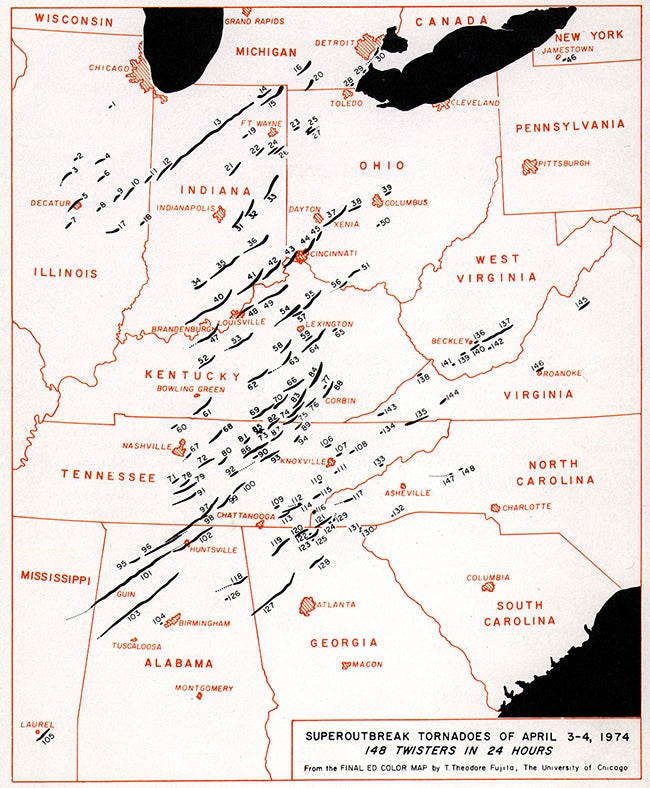(Thread) Today is one of the most notorious #OTD in #weather, the April 3, 1974 Superoutbreak.
-148 tornadoes in 13 states and Canada
- 30 "violent tornadoes", including six rated F5
- 307 killed, 5454 injured
- Total damage: $1.5 billion
-148 tornadoes in 13 states and Canada
- 30 "violent tornadoes", including six rated F5
- 307 killed, 5454 injured
- Total damage: $1.5 billion
Some other incredible facts:
- Total tornadoes path length: 2,521 miles (Dr. Greg Forbes)
- 16 tornadoes were in progress at once in Indiana alone.
- Guin, Alabama, was leveled by an F5 tornado with a forward speed of *75 mph*.
- Total tornadoes path length: 2,521 miles (Dr. Greg Forbes)
- 16 tornadoes were in progress at once in Indiana alone.
- Guin, Alabama, was leveled by an F5 tornado with a forward speed of *75 mph*.
In 1974, Doppler radar was merely in development in the research community.
Radar available to operational meteorology was crude and labor intensive, by modern standards.
The 1974 Superoutbreak gave a boost in urgency for Doppler radar research and development.
Radar available to operational meteorology was crude and labor intensive, by modern standards.
The 1974 Superoutbreak gave a boost in urgency for Doppler radar research and development.
In the pre-Doppler era, forecasters in 1974 were often unable to issue tornado warnings simply based on examining the green splotches on their radar.
Until visual confirmation of a tornado was received, a warning was typically not issued.
Until visual confirmation of a tornado was received, a warning was typically not issued.
In 1974, warnings were disseminated using a teletype system in which warnings had to be punched into a paper tape, then manually fed through a reader.
With many tornadoes in progress, there was a bottleneck. Some warnings weren& #39;t transmitted until 1 hour after originally issued.
With many tornadoes in progress, there was a bottleneck. Some warnings weren& #39;t transmitted until 1 hour after originally issued.
A faster weather wire was implemented soon after the 1974 Superoutbreak, and warnings were properly prioritized over other NWS products.
Today, we can receive warnings via television, social media or a smartphone app the instant they& #39;re issued.
Today, we can receive warnings via television, social media or a smartphone app the instant they& #39;re issued.
Given the bottleneck of transmitting numerous warnings via teletype, NWS knew they needed a better way to get a warning directly to the public.
Thus, NOAA Weather Radio expanded from only 50-60 stations mostly in large cities near the coasts to include another 330 stations.
Thus, NOAA Weather Radio expanded from only 50-60 stations mostly in large cities near the coasts to include another 330 stations.
For first time, anyone with a wx radio could be alerted immediately when their NWS office issues a warning for their area. Later on, a tone alert feature was added to wake someone at night.
Today, there are > 1,000 transmitters covering all 50 states, P.R./V.I., Pac territories.
Today, there are > 1,000 transmitters covering all 50 states, P.R./V.I., Pac territories.
Some schools hit during the 1974 Superoutbreak had never conducted a tornado drill.
Monticello, Indiana, lost three schools to one tornado and there were 24 schools damaged in Indiana. Seven of Xenia, Ohio& #39;s 12 schools were hit on April 3, 1974.
Monticello, Indiana, lost three schools to one tornado and there were 24 schools damaged in Indiana. Seven of Xenia, Ohio& #39;s 12 schools were hit on April 3, 1974.
While meant for those outdoors, a large number of communities invested in tornado sirens after the 1974 Superoutbreak.
Several long-held tornado myths were crushed:
- Buildings don& #39;t explode due to pressure differences. Opening windows wastes time.
- Tornadoes can climb/descend mtns. (Guin, Ala. tor moved over Monte Sano Mtn.)
- Rivers don& #39;t matter. (Cairo, Ill. and Sayler Park, OH F5)
- Buildings don& #39;t explode due to pressure differences. Opening windows wastes time.
- Tornadoes can climb/descend mtns. (Guin, Ala. tor moved over Monte Sano Mtn.)
- Rivers don& #39;t matter. (Cairo, Ill. and Sayler Park, OH F5)
While damage surveys had been conducted before, the 1974 Superoutbreak offered a chance to conduct the largest storm survey ever at the time.
Dr. Theodore Fujita and his group from UIC (including former severe weather expert Dr. Greg Forbes), investigated every tornado track.
Dr. Theodore Fujita and his group from UIC (including former severe weather expert Dr. Greg Forbes), investigated every tornado track.
In April 1974 alone, Fujita logged over 13,000 flight miles in his Cessna conducting aerial surveys, almost halfway around the world, Dr. Forbes told us in 2014.
It took just over 3 months for the team to investigate every track, using initial reports from NSSFC and local news.
It took just over 3 months for the team to investigate every track, using initial reports from NSSFC and local news.
If it wasn& #39;t for the & #39;74 Superoutbreak, Dr. Greg Forbes (former TWC severe weather expert) might have become a hurricane expert, instead...
"Dr. Fujita was running out of research funds to support my studies," Forbes told us.
"I was literally in an interview to possibly get funding that would have had me studying the formation of tropical storms off the coast of Africa when a hailstorm came over our building."
"I was literally in an interview to possibly get funding that would have had me studying the formation of tropical storms off the coast of Africa when a hailstorm came over our building."
After the outbreak, Fujita told Forbes his funding would be renewed.
"My doctoral studies were primarily supported by the U.S. Nuclear Regulatory Commission, who wanted to know more about tornado intensity and characteristics in order to ensure reactor safety," Forbes told us.
"My doctoral studies were primarily supported by the U.S. Nuclear Regulatory Commission, who wanted to know more about tornado intensity and characteristics in order to ensure reactor safety," Forbes told us.

 Read on Twitter
Read on Twitter


